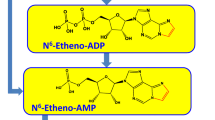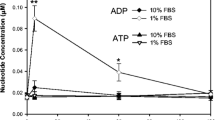Abstract
The effect of several adenosine analogues on cyclic AMP accumulation was examined in the rat phaeochromocytoma cell PC12 and in the human T-cell leukaemia cell Jurkat, selected as prototypes of cells predominantly expressing adenosine A2A or A2B receptors. Using the reverse transcription-polymerase chain reaction it was, however, demonstrated that the Jurkat cell and the PC12 cell express both A2A and A2B receptor mRNA, albeit in different relative proportions. In PC12 cells the concentration required for half-maximal response (EC50) for the full agonist 5′-N-ethyl-car-boxamidoadenosine (NECA) was 30 times lower than in Jurkat cells. There was no significant difference in the pA2 for the antagonist 5-amino-9-chloro-2-(2-furanyl)1,2,4-triazolo(1,5-C)quinazolinemonomethanesulphon-ate (CGS 15943) between the two cell types. In the presence of forskolin (1 μM in PC12 cells; 10 μM in Jurkat cells) the EC50 value for NECA was reduced two-to sixfold. Forskolin also increased the maximal cAMP accumulation twofold in PC12 cells and sevenfold in Jurkat cells. A series of 2-substituted adenosine analogues CV 1808 (2-phenylamino adenosine), CV 1674 [2-(4-methoxyphenyl)adenosine], CGS 21680 {2-[p-(2-carbonylethyl)phenylethylamino]-5′-N-ethyl-carboxamido adenosine}, and four 2-substituted isoguanosines, SHA 40 [2-(2-phenylethoxy)adenosine; PEA], SHA 91 [2-(2-cyclohexylethoxy)adenosine; CEA], SHA 118 {2-[2-(p-methylphenyl)ethoxy]adenosine; MPEA}, and SHA 125 (2-hexyloxyadenosine; HOA), all raised CAMP accumulation in PC12 cells, but had minimal or no effect in Jurkat cells. In the PC12 cells the addition of forskolin (1 μM) reduced the EC50 by a factor of 2 (CV 1808) to 12 (SHA 125). In Jurkat cells all the analogues gave a significant, but submaximal, cAMP response in the presence of forskolin (10 μM), but they were essentially inactive in its absence. The results show that a series of 2-substituted adenosine analogues can be used to discriminate between A2A and A2B receptors. The two receptor subtypes appear to coexist, even in clonal cells selected for typical pharmacology. A2 receptor pharmacology can therefore be complex.
Similar content being viewed by others
References
Bristol JA, Bridges AJ, Bruns RF, Downs DA, Heffner TG, Moos WH, Ortwine DF, Szotek DL, Trivedi BK (1988) The search for purine and ribose-substituted adenosine analogs with potential clinical application. 1n: Paton DM (ed) Adenosine and adenine nucleotides. Physiology and pharmacology. Taylor and Francis, Basingstoke, pp 17–27
Bruns RF, Lu GH, Pugsley TA (1986) Characterization of the A2 adenosine receptor labeled by [3H]-NECA in rat striatal membranes. Mol Pharmacol 29:331–346
Chern Y, Lai H-L, Fong JC, Liang Y (1993) Multiple mechanisms for desensitization of A2a adenosine receptor-mediated CAMP elevation in rat pheochromocytoma PC12 cells. Mol Pharmacol 44:950–958
Cunha RA, Johansson B, Ploeg I van der, Sebastião AM, Ribeiro AJ, Fredholm BB (1994) Evidence for functionally important adenosine A2a receptors in the rat hippocampus. Brain Res 649: 208–216
Fink JS, Weaver DR, Rivkees SA, Peterfreund RA, Pollack AE, Adler EM, Reppert SM (1992) Molecular cloning of the rat A2 adenosine receptor: selective co-expression with D2 dopamine receptors in rat striatum. Mol Brain Res 14: 186–195
Fredholm BB, Abbracchio MP, Burnstock G, Daly JW, Harden TK, Jacobson KA, Leff P, Williams M (1994) Nomenclature and classification of purinoceptors. Pharmacol Rev 46:143–156
Fredholm BB, Ahlberg S, Altiok N, Gerwins P, Parkinson F, Ploeg I van der, Kvanta A, Nordstedt C, Dunwiddie T (1991) Interactions between adenosine receptors and other membrane receptors. In: Imai S, Nakazawa M (eds) Role of adenosine and adenine nucleotides in the biological system. Elsevier, Amsterdam, pp 173–182
Fredholm BB, Altiok N, Ahlberg S, Nordstedt C (1990) CGS 21680 acts as an atypical partial agonist at AZ receptors on human T-leukemia cells (abstract). Jpn J Pharmacol 52 (suppl II): 93P
Fredholm BB, Dunwiddie TV, Bergman B, Lindström K (1984) Levels of adenosine and adenine nucleotides in slices of rat hippocampus. Brain Res 295:127–136
Fredholm BB, Jondal M, Nordstedt C (1987) The adenosine receptor mediated accumulation of cyclic AMP in Jurkat cells is enhanced by a lectin and by phorbol esters. Biochem Biophys Res Commun 145:344–349
Fredholm BB, Sandberg G (1983) Inhibition by xanthine derivatives of adenosine receptor stimulated cyclic AMP accumulation in rat and guinea pig thymocytes. Br J Pharmacol 80:639–644
Fredholm BB, Zahniser NR, Weiner GR, Proctor WR, Dunwiddie TV (1985) Behavioural sensitivity to PIA in selectively bred mice is related to a number of A1 adenosine receptors but not to cyclic AMP accumulation in brain slices. Eur J Pharmacol 111: 133–136
Furlong TJ, Pierce KD, Selbie LA, Shine J (1992) Molecular characterization of a human brain adenosine A2 receptor. Brain Res Mol Brain Res 15:62–66
Guroff G, Dickens G, End D, Londos C (1981) The action of adenosine analogues on PC12 cells. J Neurochem 37:1431–1439
Hide I, Padgett WL, Jacobson KA, Daly JW (1992) A2A adenosine receptors from rat striatum and rat pheochromocytoma PC12 cells: characterization with radioligand binding and by activation of adenylate cyclase. Mol Pharmacol 41:352–359
Hutchison AJ, Webb RL, Oci HH, Ghai GR, Zimmerman MB, Williams M (1989) 3HCGS 21680C, an A2 selective adenosine receptor agonist with preferential hypotensive activity. J Pharmacol Exp Ther 251:47–55
Hutchison KA, Nevins B, Perini F, Fox IH (1990) Soluble and membrane-associated human low-affinity adenosine binding protein (adenotin): properties and homology with mammalian and avian stress proteins. J Biochem 29:5138–5144
Jacobson KA, Pannell LK, Ji XD, Jarvis MF, Williams M, Hutchison AJ, Barrington WW, Stiles GL (1989) Agonist derived molecular probes for AZ adenosine receptors. J Mol Recognit 2:170–178
Jarvis MF, Schulz R, Hutchison AJ, Do UH, Sills MA, Williams M (1989) 3HCGS 21680, a selective A2 adenosine receptor agonist, directly labels AZ receptors in rat brain. J Pharmacol Exp Ther 251:888–893
Jonzon B, Fredholm BB (1985) Release of purines, noradrenaline and GABA from rat hippocampal slices by field stimulation. J Neurochem 44:217–224
Kenakin TP (1989) Challenges for receptor theory as a tool for drug and drug receptor classification. Trends Pharmacol Sci 10:18–22
Kozasa T, Itoh H, Tsukamoto T, Kaziro Y (1988) Isolation and characterization of the human Gsα gene. Proc Natl Acad Sci USA 85:2081–2085
Linden J, Jacobson MA, Hutchins C, Williams M (1994) Adenosine receptors. In: Peroutka SJ (ed) Handbook of receptors and channels. G protein coupled receptors. CRC Press, Boca Raton, pp 29–44
Nanoff C, Boehm S, Hohenegger M, Schütz W, Freissmuth M (1994) 2′,3′-Dialdehyde GTP as an irreversible G protein antagonist. Disruption and reconstitution of G protein-mediated signal transduction in cells and cell membranes. J Biol Chem 269: 31999–32007
Nordstedt C, Fredholm BB (1990) A modification of a protein-binding method for rapid quantification of cAMP in cell-culture supernatants and body fluid. Anal Biochem 189:231–234
Nordstedt C, Kvanta A, Ploeg I van der, Fredholm BB (1989) Dual effects of protein kinase-C on receptor stimulated cAMP accumulation in a human T-cell leukemia line. Eur J Pharmacol 172:51–60
Parkinson FE, Fredholm BB (1990) Autoradiographic evidence for G-protein coupled A2-receptors in rat neostriatum using [3H]-CGS 21680 as a ligand. Naunyn-Schmiedeberg's Arch Pharmacol 342:85–89
Pierce KD, Furlong TJ, Selbie LA, Shine J (1992) Molecular cloning and expression of an adenosine A2b receptor from human brain. Biochem Biophys Res Commun 187:86–93
Ploeg I van der, Ahlberg S, Parkinson FE, Olsson RA, Fredholm BB (1994) Cells expressing different relative amounts of adenosine A2 receptors exhibit remarkably different pharmacological properties. Drug Develop Res 31:330
Salomon Y, Londos C, Rodbell M (1974) A highly sensitive adenylate cyclase assay. Anal Biochem 58:541–548
Seamen KB, Daly JW (1981) Forskohn: a unique diterpene activator of cyclic AMP-generating systems. J Cycl Nucl Res 7:201–224
Stehle JH, Rivkees SA, Lee JJ, Weaver DR, Deeds JD, Reppert SM (1992) Molecular cloning and expression of the cDNA for a novel A2-adenosine receptor subtype. Mol Endocrinol 6:384–393
Ueeda M, Thompson RD, Arroyo LH, Olsson RA (1991a) 2-Aralkoxyadenosines: potent and selective agonists at the coronary artery A2 adenosine receptor. J Med Chem 34:1334–1344
Ueeda M, Thompson RD, Padgett WL, Secunda S, Daly JW, Olsson RA (1991b) Cardiovascular actions of adenosine, but not adenosine receptors, differ in rat and guinea-pig. Life Sci 49:1351–1358
Wilkinson M (1988) RNA isolation: a mini-prep method. Nucleic Acids Res 16:10933
Williams M, Webb RL, Oei HH, Jarvis MF, Hutchison AJ (1989) Adenosine receptor ligands as therapeutic entities: molecular specificity in relation to functional and therapeutic activity. In: Ribeiro JA (ed) Adenosine receptors in the nervous system. Taylor and Francis, Basingstoke, pp 61–68
Author information
Authors and Affiliations
Rights and permissions
About this article
Cite this article
van der Ploeg, I., Ahlberg, S., Parkinson, F.E. et al. Functional characterization of adenosine A2 receptors in Jurkat cells and PC12 cells using adenosine receptor agonists. Naunyn-Schmiedeberg's Arch Pharmacol 353, 250–260 (1996). https://doi.org/10.1007/BF00168626
Received:
Accepted:
Issue Date:
DOI: https://doi.org/10.1007/BF00168626




